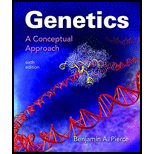
To determine:
The difference in the phenotype of albinism among Hopi Native Americans and other types of albinism and the mutated gene resulting in those
Introduction:
Albinism is a congenital disorder, which results because of the defect in enzymes required for melanin production. Melanin is the pigment that provides dark color to hair, eyes, and skin. Melanin is either not present or produced in little amounts in albino people. It protects skin from skin cancer and dark color of skin prevents DNA (deoxyribonucleic acid) from getting damage because of ultraviolet radiation.
Explanation of Solution
In Hopis, the type of albinism is oculocutaneous albinism which affects skin and eyes only. This type of albinism is caused because of defect in
OCA type II has differential phenotypes. With age, the hair of affected person might turn darker and pigmented freckles or nevi can be observed. The color of irides may be hazel or blue-gray in color in African American and African population. Brown OCA is one of the phenotypic variant. In them, the irides and hair turn darker with age and skin might develop tanning. In all the types of albinism, ocular features are common.
The tyrosinase-positive albinism is characterized by pigment nevi. In African population, the hair color is yellow and there are several pigmented spots in the skin. This kind of albinism develops because of blockage in formation of eumelanin. There are two different phenotypes in tyrosinase-positive albinism, namely- with pigmented patches and without pigmented patches. The individuals having
The individual suffering from ocular albinism may show photophobia, congenital nystagmus, translucent irides, impaired vision, strabismus, and hyperplasia of fovea.
In X-linked albinism, the heterozygous daughter did not have mosaic pattern in ocular fundus. Brown oculocutaneous albinism is linked to P locus. At this locus, OCA2 mutations are located.
Oculocutaneous albinism IA is characterized by absent or decreased melanin pigmentation in eyes, hair, and skin. The optic changes include nystagmus, misignaling of optic nerve, and decreased visual acuity. This is caused by mutation in Tyrosinase gene and is also known as tyrosinase negative OCA.
OCAIII is also known as rufous oculocutaneous albinism. In African population, it is characterized by dilution of color of iris, bright copper coloration of hair and skin. It is caused by mutation in
In OCAIV, the hair color varies between yellow to brown, patients might have nystagmus and color of iris is from blue to brown. This is caused by mutation in
OCAVI is caused by mutation in
OCAVII is caused by mutation in
There are various types of albinism, such as type IA, IB, II, III, IV, V, VI, BCOA, and VII. The types of albinism have differences in the phenotypes of the individuals.
Want to see more full solutions like this?
Chapter 1 Solutions
Genetics: A Conceptual Approach
- Molecular Biology Question Please help. Thank you Explain what is meant by the term “defective virus.” Explain how a defective virus is able to replicate.arrow_forwardMolecular Biology Explain why changing the codon GGG to GGA should not be harmful. Please help . Thank youarrow_forwardStage Percent Time in Hours Interphase .60 14.4 Prophase .20 4.8 Metaphase .10 2.4 Anaphase .06 1.44 Telophase .03 .72 Cytukinesis .01 .24 Can you summarize the results in the chart and explain which phases are faster and why the slower ones are slow?arrow_forward
- Can you circle a cell in the different stages of mitosis? 1.prophase 2.metaphase 3.anaphase 4.telophase 5.cytokinesisarrow_forwardWhich microbe does not live part of its lifecycle outside humans? A. Toxoplasma gondii B. Cytomegalovirus C. Francisella tularensis D. Plasmodium falciparum explain your answer thoroughly.arrow_forwardSelect all of the following that the ablation (knockout) or ectopoic expression (gain of function) of Hox can contribute to. Another set of wings in the fruit fly, duplication of fingernails, ectopic ears in mice, excess feathers in duck/quail chimeras, and homeosis of segment 2 to jaw in Hox2a mutantsarrow_forward
- Select all of the following that changes in the MC1R gene can lead to: Changes in spots/stripes in lizards, changes in coat coloration in mice, ectopic ear formation in Siberian hamsters, and red hair in humansarrow_forwardPleiotropic genes are genes that (blank) Cause a swapping of organs/structures, are the result of duplicated sets of chromosomes, never produce protein products, and have more than one purpose/functionarrow_forwardA loss of function mutation in Pitx1 enhancers can cause (blank) Removal of Pitx1 exons and growth of ectopic hindlimbs, growth of extra ectopic forelimbs, loss of forelimb specification and development, and loss of hindlimb specification and developmentarrow_forward
- Hox1a most likely contributes to (blank) patterning in the developing embryo? Ventral, posterior, limb or anteriorarrow_forwardSelect all of the following that can help establish Hox gene expression boundaries (things that affect Hox and not things that Hox affects). Retinoic acid, anterior/posterior axis, fibroblast growth factors, vagal neural crest, and enhancersarrow_forwardEctopic expression of Hox often results in (blank) phenotypes. (Blank) transformations are characterized by the replacement of one body part/structure with another. Hoxeotic, homealoneotic, joexotic, or homeoticarrow_forward
 Human Anatomy & Physiology (11th Edition)BiologyISBN:9780134580999Author:Elaine N. Marieb, Katja N. HoehnPublisher:PEARSON
Human Anatomy & Physiology (11th Edition)BiologyISBN:9780134580999Author:Elaine N. Marieb, Katja N. HoehnPublisher:PEARSON Biology 2eBiologyISBN:9781947172517Author:Matthew Douglas, Jung Choi, Mary Ann ClarkPublisher:OpenStax
Biology 2eBiologyISBN:9781947172517Author:Matthew Douglas, Jung Choi, Mary Ann ClarkPublisher:OpenStax Anatomy & PhysiologyBiologyISBN:9781259398629Author:McKinley, Michael P., O'loughlin, Valerie Dean, Bidle, Theresa StouterPublisher:Mcgraw Hill Education,
Anatomy & PhysiologyBiologyISBN:9781259398629Author:McKinley, Michael P., O'loughlin, Valerie Dean, Bidle, Theresa StouterPublisher:Mcgraw Hill Education, Molecular Biology of the Cell (Sixth Edition)BiologyISBN:9780815344322Author:Bruce Alberts, Alexander D. Johnson, Julian Lewis, David Morgan, Martin Raff, Keith Roberts, Peter WalterPublisher:W. W. Norton & Company
Molecular Biology of the Cell (Sixth Edition)BiologyISBN:9780815344322Author:Bruce Alberts, Alexander D. Johnson, Julian Lewis, David Morgan, Martin Raff, Keith Roberts, Peter WalterPublisher:W. W. Norton & Company Laboratory Manual For Human Anatomy & PhysiologyBiologyISBN:9781260159363Author:Martin, Terry R., Prentice-craver, CynthiaPublisher:McGraw-Hill Publishing Co.
Laboratory Manual For Human Anatomy & PhysiologyBiologyISBN:9781260159363Author:Martin, Terry R., Prentice-craver, CynthiaPublisher:McGraw-Hill Publishing Co. Inquiry Into Life (16th Edition)BiologyISBN:9781260231700Author:Sylvia S. Mader, Michael WindelspechtPublisher:McGraw Hill Education
Inquiry Into Life (16th Edition)BiologyISBN:9781260231700Author:Sylvia S. Mader, Michael WindelspechtPublisher:McGraw Hill Education





